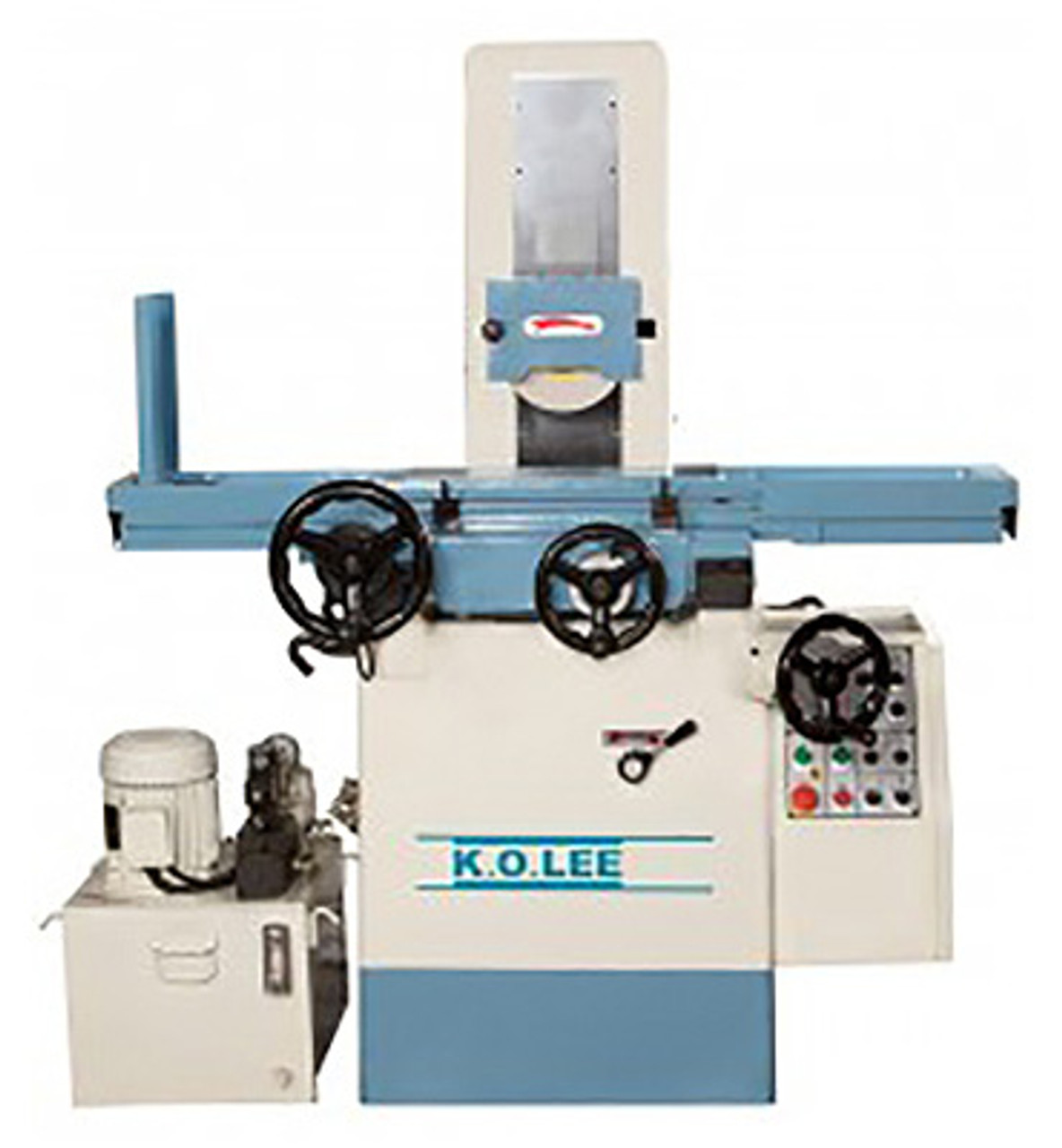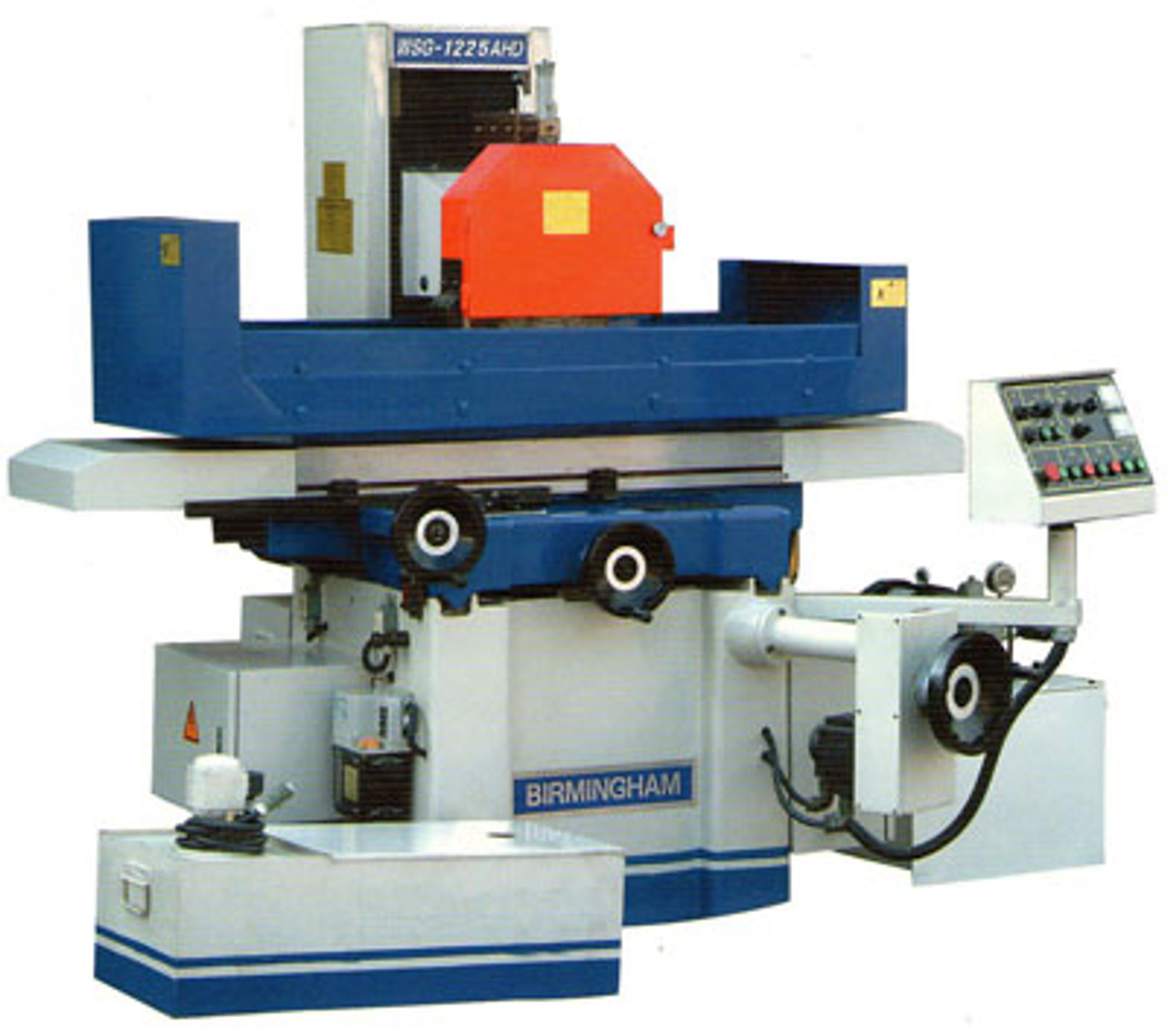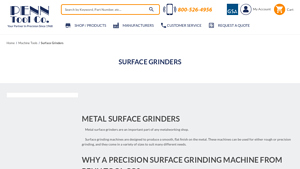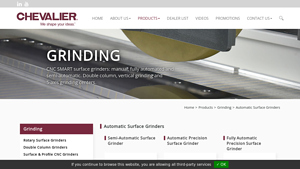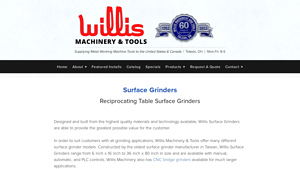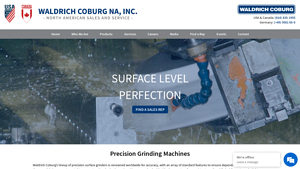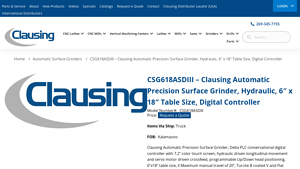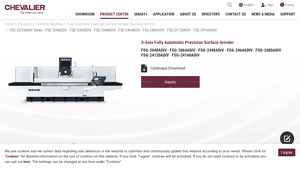Precision Surface Grinder Guide: Type, Cost, Top List…
Introduction: Navigating the Global Market for precision surface grinder
In today’s competitive landscape, sourcing precision surface grinders that meet the specific demands of your operations can be a daunting challenge for B2B buyers, especially in regions like Africa, South America, the Middle East, and Europe. The need for high-quality surface grinding equipment is paramount for ensuring optimal manufacturing processes, yet navigating the myriad of options available in the global market can lead to confusion and uncertainty. This guide aims to demystify the complexities surrounding precision surface grinders, providing a comprehensive resource that covers various types of machines, their applications across industries, and essential supplier vetting strategies.
From manual to fully automatic models, our exploration will highlight the key features and benefits of each type, helping you identify which precision surface grinder aligns best with your operational requirements. Additionally, we will delve into cost considerations, ensuring you are equipped with the knowledge to make informed purchasing decisions without compromising on quality.
By leveraging the insights and actionable strategies presented in this guide, international B2B buyers can confidently navigate the global market for precision surface grinders. Whether you are in Brazil, Germany, or elsewhere, our goal is to empower you with the tools needed to enhance your procurement process, ultimately leading to improved productivity and profitability in your operations.
Understanding precision surface grinder Types and Variations
| Type Name | Key Distinguishing Features | Primary B2B Applications | Brief Pros & Cons for Buyers |
|---|---|---|---|
| Manual Surface Grinders | Operated by hand; offers control over grinding process | Tool shops, small machine shops | Pros: Cost-effective, simple operation. Cons: Labor-intensive, less efficient for large runs. |
| Automatic Surface Grinders | Fully automated; programmable for precision and speed | High-volume production, automotive components | Pros: Increased productivity, consistent results. Cons: Higher initial investment, complex setup. |
| CNC Surface Grinders | Computer-controlled; allows for intricate designs and shapes | Aerospace, medical device manufacturing | Pros: High precision, versatility in design. Cons: Requires skilled operators, maintenance can be costly. |
| Rotary Surface Grinders | Features a rotating table for continuous grinding | Large-scale manufacturing, heavy machinery | Pros: Efficient for large parts, consistent finish. Cons: Requires substantial floor space, higher energy consumption. |
| Double Column Surface Grinders | Robust construction; accommodates larger workpieces | Heavy-duty machining, mold making | Pros: Stability for large parts, high accuracy. Cons: Expensive, complex operation. |
What Are the Characteristics of Manual Surface Grinders?
Manual surface grinders are designed for smaller scale operations where precision is paramount but volume is limited. They are operated by hand, allowing skilled operators to have direct control over the grinding process. This type is especially suitable for tool shops and small machine shops that require high-quality finishes on individual pieces. When considering a manual surface grinder, buyers should assess the skill level of their operators and the volume of work, as these machines can be labor-intensive and less efficient for larger production runs.
How Do Automatic Surface Grinders Enhance Production Efficiency?
Automatic surface grinders are engineered for high-volume production environments. These machines can be programmed for precise grinding tasks, significantly enhancing productivity and consistency in results. They are ideal for industries such as automotive manufacturing where repetitive tasks are common. Buyers should evaluate their production needs and budget, as these machines come with a higher initial investment but offer substantial long-term savings through efficiency.
Why Invest in CNC Surface Grinders for Precision Work?
CNC surface grinders utilize computer numerical control to achieve intricate designs and high precision. They are commonly used in sectors like aerospace and medical device manufacturing, where tolerances are critical. The versatility of CNC machines allows for complex profiles and shapes, making them a valuable investment for companies looking to innovate. However, buyers must consider the need for skilled operators and the potential costs of maintenance when investing in CNC technology.
What Advantages Do Rotary Surface Grinders Offer in Manufacturing?
Rotary surface grinders are distinguished by their rotating tables, which provide continuous grinding capabilities. This design is particularly effective for large-scale manufacturing applications, such as heavy machinery production, where efficiency and consistent finishing are essential. While these grinders can handle larger parts, buyers should be mindful of the space requirements and higher energy consumption associated with rotary grinders.
When Should You Choose Double Column Surface Grinders?
Double column surface grinders are built for heavy-duty machining and are well-suited for larger workpieces. Their robust construction ensures stability during the grinding process, which is crucial for achieving high accuracy. Industries involved in mold making or other heavy machining tasks will find this type advantageous. However, the cost and complexity of operation should be weighed against the specific needs of the business, as they represent a significant investment.
Key Industrial Applications of precision surface grinder
| Industry/Sector | Specific Application of Precision Surface Grinder | Value/Benefit for the Business | Key Sourcing Considerations for this Application |
|---|---|---|---|
| Aerospace | Precision grinding of turbine components | Ensures high tolerance and performance in critical components | Need for machines that provide high stability and low vibration |
| Automotive | Surface finishing of engine parts | Enhances durability and efficiency of engine components | Consideration for the size and weight of machinery for space constraints |
| Tool and Die Manufacturing | Grinding of molds and dies | Achieves precise dimensions for better fit and function | Requirement for customizable options to meet specific mold designs |
| Electronics | Grinding of heat sinks and connectors | Improves thermal conductivity and overall product reliability | Need for machines with advanced cooling systems for sensitive components |
| Medical Devices | Surface finishing of surgical instruments | Ensures compliance with stringent hygiene and precision standards | Importance of sourcing reliable machines with low maintenance needs |
How Is Precision Surface Grinding Applied in Aerospace?
In the aerospace industry, precision surface grinders are essential for the grinding of turbine components, where exact tolerances are crucial. These grinders enhance the performance and reliability of critical parts, ensuring they meet stringent safety standards. International buyers, particularly from regions like Europe and the Middle East, must prioritize machines that offer high stability and low vibration. This is vital as any imperfections can lead to significant operational failures. Additionally, sourcing should focus on equipment that can handle the specific material properties of aerospace alloys.
What Role Does Precision Surface Grinding Play in Automotive Manufacturing?
In the automotive sector, precision surface grinders are utilized for the surface finishing of engine parts, such as cylinder heads and crankshafts. The grinding process improves the durability and efficiency of these components, ultimately enhancing vehicle performance. For B2B buyers in South America and Africa, it is crucial to consider the size and weight of the machinery, as many production facilities may have limited space. Additionally, investing in machines that offer versatility and the ability to handle various materials can provide a competitive edge in this rapidly evolving market.
How Are Precision Surface Grinders Used in Tool and Die Manufacturing?
Tool and die manufacturing heavily relies on precision surface grinders for grinding molds and dies. This application demands extremely precise dimensions to ensure that parts fit perfectly during assembly. Buyers from regions like Brazil and Germany should seek grinders that can be customized to meet specific mold designs, as the ability to adapt to unique specifications can significantly enhance production efficiency. Moreover, sourcing machines with robust support and service options is crucial to minimize downtime and maintain operational flow.
In What Ways Are Precision Surface Grinders Beneficial in Electronics?
In the electronics industry, precision surface grinders are employed for grinding heat sinks and connectors, which are vital for thermal management in electronic devices. The grinding process enhances thermal conductivity, thereby improving the reliability and performance of electronic products. For international buyers, particularly in emerging markets, it is essential to consider machines equipped with advanced cooling systems to protect sensitive components. Additionally, ensuring that the equipment has a low maintenance requirement will help sustain operational efficiency.
Why Is Precision Surface Grinding Important for Medical Devices?
Precision surface grinders are pivotal in the medical device industry, particularly for the surface finishing of surgical instruments. The grinding process must adhere to strict hygiene and precision standards, as these instruments are critical for patient safety. Buyers in the medical field should prioritize sourcing reliable machines that guarantee low maintenance needs, as downtime can have significant repercussions in a medical context. Moreover, understanding the regulatory requirements for medical devices in different regions will help buyers select appropriate grinding solutions.
3 Common User Pain Points for ‘precision surface grinder’ & Their Solutions
Scenario 1: Inconsistent Grinding Precision Affects Quality Control
The Problem: One of the most pressing challenges faced by B2B buyers of precision surface grinders is the inconsistency in grinding precision, which can lead to significant quality control issues. For instance, a manufacturing company in Brazil may find that their surface grinder produces uneven finishes, causing parts to fail inspection. This inconsistency not only results in wasted materials and labor but also jeopardizes customer satisfaction and the company’s reputation in a competitive market.
The Solution: To overcome this problem, it’s crucial to invest in a high-quality precision surface grinder that meets the specific requirements of the operation. Buyers should focus on machines with advanced features such as high-precision spindles and robust construction materials, which contribute to stability and accuracy. Additionally, implementing a regular maintenance schedule can help ensure that the grinder operates at optimal levels. This includes regularly checking alignment, cleaning components, and replacing worn-out parts. Furthermore, operators should be trained in the correct setup and operation of the machine, including the selection of appropriate grinding wheels and techniques to achieve consistent finishes. By doing so, businesses can significantly reduce variability and enhance product quality.
Scenario 2: Difficulty in Finding the Right Grinder for Specific Applications
The Problem: Many B2B buyers encounter challenges when trying to select the right precision surface grinder for their specific applications. For example, a metalworking shop in Germany might require a machine capable of grinding both small and large parts with varying material hardness. Without clear guidance, buyers may end up purchasing a machine that is either overpowered or underperforming for their needs, leading to inefficiencies and increased operational costs.
The Solution: To address this issue, buyers should conduct a comprehensive needs assessment before making a purchase. This involves analyzing the types of materials processed, the size of the components, and the desired finish quality. Once these factors are clearly defined, it’s advisable to consult with multiple suppliers to gain insights into the best-fit machines for the applications. Buyers should also consider grinders with adjustable settings and versatile features, such as CNC capabilities or the option for different grinding attachments. Additionally, participating in industry trade shows or webinars can provide valuable information on the latest technologies and equipment options, ensuring buyers make informed decisions that align with their operational goals.
Scenario 3: High Maintenance Costs and Downtime
The Problem: High maintenance costs and unexpected downtime are significant pain points for B2B buyers of precision surface grinders. For instance, a machining company in South Africa may experience frequent breakdowns due to inadequate maintenance practices or the use of low-quality replacement parts. This situation not only leads to costly repairs but also disrupts production schedules, resulting in lost revenue and client trust.
The Solution: To mitigate these issues, buyers should prioritize the selection of machines known for their durability and low maintenance requirements. Investing in reputable brands that offer reliable warranty services and customer support can also make a difference in managing maintenance costs. Implementing a predictive maintenance program that utilizes technology to monitor machine performance can help identify potential issues before they lead to breakdowns. This proactive approach allows businesses to schedule maintenance during non-peak hours, minimizing downtime. Additionally, creating a comprehensive maintenance log can help track service history and inform decisions about parts replacement, ensuring that only high-quality components are used. By fostering a culture of preventive maintenance, businesses can enhance the longevity of their precision surface grinders and reduce overall operational costs.
Strategic Material Selection Guide for precision surface grinder
What Are the Key Materials Used in Precision Surface Grinders?
When selecting a precision surface grinder, the choice of materials significantly influences the machine’s performance, durability, and suitability for specific applications. Understanding the properties, advantages, and limitations of common materials can guide international B2B buyers in making informed decisions.
How Does Cast Iron Benefit Precision Surface Grinders?
Cast iron is a traditional material for constructing the base and frame of surface grinders. Its key properties include excellent vibration dampening, high rigidity, and resistance to deformation under load. This makes cast iron ideal for maintaining precision during grinding operations.
Pros:
– Durability: Cast iron is robust and can withstand heavy usage.
– Cost-Effective: Generally lower in cost compared to other materials.
– Stability: Offers excellent thermal stability, reducing the risk of warping.
Cons:
– Weight: Heavy, which can complicate installation and transportation.
– Corrosion: Prone to rusting if not properly maintained, especially in humid environments.
Impact on Application: Cast iron’s stability makes it suitable for a wide range of grinding operations, particularly in environments with varying temperatures.
Considerations for International Buyers: Compliance with local standards such as ASTM or DIN is crucial. Buyers from humid regions like parts of Africa and South America should consider additional coatings to prevent corrosion.
What Role Does Steel Play in Precision Surface Grinders?
Steel, particularly high-carbon steel, is often used for components like the grinding wheel spindle and table. Steel’s high tensile strength and resistance to wear make it a favored choice for precision applications.
Pros:
– Strength: High tensile strength allows for precision under heavy loads.
– Versatility: Can be heat-treated for enhanced performance.
Cons:
– Cost: Generally more expensive than cast iron.
– Corrosion Vulnerability: Requires protective coatings to prevent rust.
Impact on Application: Steel components contribute to the overall precision of the grinder, making it suitable for high-precision tasks in industries such as aerospace and automotive.
Considerations for International Buyers: Buyers should ensure that steel components meet international standards for hardness and wear resistance, particularly in competitive markets like Europe and the Middle East.
How Do Composite Materials Enhance Precision Surface Grinders?
Composite materials, including polymers and advanced composites, are increasingly being used in precision surface grinders for non-structural components. They offer unique properties that can enhance performance.
Pros:
– Lightweight: Reduces the overall weight of the machine.
– Corrosion Resistance: Excellent resistance to chemicals and moisture.
Cons:
– Cost: Higher manufacturing costs compared to traditional materials.
– Temperature Sensitivity: Performance can degrade at high temperatures.
Impact on Application: Composites can be used for parts that require less structural integrity but high resistance to corrosion, making them ideal for specific industries like food processing and pharmaceuticals.
Considerations for International Buyers: Buyers should verify that composite materials used meet relevant international standards, particularly in sectors with stringent safety regulations.
What Advantages Do Ceramics Offer in Precision Surface Grinders?
Ceramics are used in high-performance grinding applications, particularly for grinding wheels. Their hardness and thermal resistance make them suitable for demanding environments.
Pros:
– Hardness: Extremely hard, allowing for efficient grinding of tough materials.
– Thermal Stability: Maintains performance under high temperatures.
Cons:
– Brittleness: Prone to cracking under shock loads.
– Cost: Generally more expensive than metals.
Impact on Application: Ceramics are ideal for precision grinding of hard materials, such as ceramics themselves or hardened steels, making them suitable for specialized industries.
Considerations for International Buyers: Buyers must ensure that ceramic components comply with international standards for wear resistance and safety, particularly in high-stakes industries in Europe and the Middle East.
Summary Table of Material Selection for Precision Surface Grinders
| Material | Typical Use Case for precision surface grinder | Key Advantage | Key Disadvantage/Limitation | Relative Cost (Low/Med/High) |
|---|---|---|---|---|
| Cast Iron | Base and frame construction | Excellent vibration dampening | Heavy and prone to corrosion | Low |
| Steel | Spindles and tables | High tensile strength | Requires protective coatings | Med |
| Composite | Non-structural components | Lightweight and corrosion-resistant | Higher manufacturing costs | High |
| Ceramics | Grinding wheels | Extremely hard and thermally stable | Brittle and expensive | High |
This strategic material selection guide provides essential insights for international B2B buyers, helping them navigate the complexities of precision surface grinder materials and their implications for performance and compliance.
In-depth Look: Manufacturing Processes and Quality Assurance for precision surface grinder
What Are the Main Stages in the Manufacturing Process of Precision Surface Grinders?
The manufacturing process of precision surface grinders involves several critical stages that ensure the machines meet high-performance standards. These stages include material preparation, forming, assembly, and finishing.
-
Material Preparation: The foundation of any precision surface grinder is the quality of the raw materials. Typically, high-grade cast iron or steel is used for the machine’s frame and components due to their stability and durability. Materials are often sourced from reputable suppliers to ensure consistency. Before machining, materials undergo a thorough inspection to check for defects or impurities that could affect performance.
-
Forming: The forming process involves machining the raw materials into specific shapes and sizes. Techniques such as CNC milling, turning, and grinding are commonly employed to achieve precision tolerances. Advanced CNC technology allows for high repeatability and accuracy, which is essential for components like the grinding table and spindle housing.
-
Assembly: Once the components are machined, they are assembled in a controlled environment to minimize contamination and ensure precision alignment. Each part, from the spindle to the magnetic chuck, is carefully fitted to maintain tight tolerances. Skilled technicians often perform this assembly, leveraging their expertise to ensure that all components work harmoniously.
-
Finishing: The finishing stage is crucial for achieving the desired surface quality. This may involve additional grinding, polishing, or coating processes to enhance durability and performance. Finishing not only improves aesthetics but also ensures that the machine operates smoothly without excessive wear.
How Do Manufacturers Ensure Quality Assurance in Precision Surface Grinders?
Quality assurance is paramount in the production of precision surface grinders. Manufacturers adhere to international standards and implement rigorous quality control (QC) processes throughout the manufacturing cycle.
-
Relevant International Standards: Many manufacturers comply with ISO 9001, which sets out criteria for a quality management system. This ensures that products consistently meet customer and regulatory requirements. Additionally, certifications such as CE mark and API standards may be relevant, particularly for products intended for specific industries or regions.
-
Quality Control Checkpoints:
– Incoming Quality Control (IQC): This initial checkpoint involves inspecting raw materials and components upon arrival. This ensures that only materials meeting specified standards enter the production process.
– In-Process Quality Control (IPQC): During manufacturing, various inspections are conducted at different stages. This includes dimensional checks and functional tests to ensure components meet design specifications.
– Final Quality Control (FQC): After assembly, the entire machine undergoes a comprehensive inspection. This includes performance testing, where grinders are evaluated for precision, vibration, and overall functionality. -
Common Testing Methods: Manufacturers typically employ a range of testing methods, including:
– Dimensional Inspection: Using gauges and calipers to measure critical dimensions.
– Functional Testing: Running the machine under load to ensure it performs as expected.
– Vibration Analysis: Assessing the machine’s operation to prevent premature wear or failure.
What Steps Can B2B Buyers Take to Verify Supplier Quality Control?
For B2B buyers, especially those in regions like Africa, South America, the Middle East, and Europe, verifying a supplier’s quality control processes is crucial for ensuring reliable machinery.
-
Supplier Audits: Conducting on-site audits allows buyers to assess the manufacturer’s facilities, equipment, and processes firsthand. This helps to ensure that the supplier adheres to their claimed quality standards and practices.
-
Quality Reports: Requesting documentation related to quality control practices, such as inspection reports, compliance certifications, and testing results, provides insight into the supplier’s commitment to quality.
-
Third-Party Inspections: Engaging third-party inspection services can provide an unbiased assessment of the supplier’s quality control measures. These organizations can conduct inspections at various stages of the manufacturing process and provide detailed reports.
-
Quality Certification Verification: Buyers should verify that the supplier holds valid certifications (ISO 9001, CE, etc.) and check their standing with the certifying bodies. This can often be done through official websites or industry associations.
What Are the Quality Control Nuances for International B2B Buyers?
Understanding the quality control nuances is essential for international buyers, as different regions may have varying standards and practices.
-
Cultural and Regulatory Differences: Buyers must be aware of the regulatory environment in the supplier’s country. Different regions may have specific requirements for certifications, safety standards, and environmental regulations. For example, European standards may be stricter than those in other regions, impacting the choice of suppliers.
-
Communication and Documentation: Clear communication regarding quality expectations is vital. Buyers should ensure that all specifications are documented and agreed upon to avoid misunderstandings. Language barriers can also pose challenges; thus, having bilingual representatives or translators may facilitate smoother transactions.
-
Logistics and Supply Chain Considerations: The supply chain can significantly affect quality. Buyers should consider the logistics involved in transporting equipment and how it may impact the machine’s condition upon arrival. Ensuring that suppliers use proper packaging and handling procedures can mitigate risks of damage during transit.
-
Post-Purchase Support: Quality assurance does not end with the purchase. Buyers should inquire about the supplier’s after-sales support, including warranties, maintenance services, and spare parts availability. This is particularly important for international buyers, as accessing support may be more challenging across borders.
By understanding the manufacturing processes and quality assurance measures associated with precision surface grinders, B2B buyers can make informed decisions and secure reliable machinery that meets their operational needs.
Practical Sourcing Guide: A Step-by-Step Checklist for ‘precision surface grinder’
Introduction
In the competitive landscape of manufacturing, selecting the right precision surface grinder is crucial for maintaining product quality and operational efficiency. This guide provides B2B buyers with a systematic approach to sourcing precision surface grinders, ensuring informed decisions that align with specific business needs.
Step 1: Define Your Technical Specifications
Before initiating the procurement process, clearly outline the technical specifications required for your precision surface grinder. Consider factors such as grinding size, spindle speed, and the types of materials you will be working with. This step is essential to ensure that the machine can handle your specific applications effectively.
- Grinding Capacity: Determine the maximum size of the workpieces.
- Precision Level: Identify the required tolerances and surface finish quality.
Step 2: Set Your Budget
Establishing a budget is a critical aspect of the sourcing process. Understand the total cost of ownership, including initial purchase price, maintenance, and operational costs. This will help in identifying machines that not only fit your budget but also deliver value over time.
- Initial Investment: Account for the price of the machine itself.
- Operational Costs: Consider energy consumption and potential wear-and-tear expenses.
Step 3: Evaluate Potential Suppliers
Conduct thorough research on potential suppliers to ensure you choose a reliable partner. Look for established manufacturers with a proven track record in delivering high-quality precision surface grinders. Request company profiles, references, and case studies to gauge their credibility.
- Supplier Background: Investigate their history, market presence, and customer feedback.
- Product Range: Ensure they offer a variety of models that meet your specifications.
Step 4: Check for Certifications and Compliance
Verify that the suppliers’ machines meet international safety and quality standards. Certifications such as ISO or CE indicate adherence to rigorous manufacturing processes, which can be crucial for reliability and safety in operations.
- Quality Assurance: Look for suppliers that provide warranty and service agreements.
- Compliance: Ensure that machines are compliant with local regulations in your region.
Step 5: Assess After-Sales Support
Robust after-sales support is a key factor in the long-term success of your investment. Evaluate the supplier’s customer service, availability of spare parts, and technical support. This can greatly reduce downtime and maintenance costs.
- Service Availability: Check if they offer on-site support or remote assistance.
- Parts Supply: Ensure that spare parts are readily available and reasonably priced.
Step 6: Request Demonstrations and Trials
Whenever possible, request a demonstration of the precision surface grinder in action. This allows you to evaluate the machine’s performance, ease of operation, and suitability for your specific needs. A hands-on trial can provide insights that specifications alone may not reveal.
- Performance Evaluation: Assess grinding speed, precision, and ease of use during the demo.
- Operator Feedback: Involve your operators in the evaluation process for practical insights.
Step 7: Negotiate Terms and Close the Deal
Once you have selected a preferred supplier, engage in negotiations to finalize terms. Discuss pricing, delivery timelines, installation, and training services. Ensure that all agreements are documented to protect your interests.
- Payment Terms: Clarify payment structures, including deposits and payment timelines.
- Installation Support: Confirm that the supplier will assist with setup and training for your team.
By following these steps, B2B buyers can confidently navigate the sourcing process for precision surface grinders, ensuring that their investment aligns with both operational needs and budgetary constraints.
Comprehensive Cost and Pricing Analysis for precision surface grinder Sourcing
What Are the Key Cost Components in Precision Surface Grinder Manufacturing?
Understanding the cost structure of precision surface grinders is essential for B2B buyers seeking to make informed purchasing decisions. The primary cost components include:
-
Materials: The choice of materials significantly impacts the overall cost. High-quality steel and cast iron are common for durability and precision, while components like spindles and bearings may use specialized alloys that increase material costs.
-
Labor: Skilled labor is required for both assembly and quality assurance. Labor costs can vary by region, with countries that have higher wages contributing to a more expensive final product.
-
Manufacturing Overhead: This encompasses costs related to factory operations, including utilities, equipment maintenance, and facility rent. Efficient manufacturing processes can help mitigate these costs.
-
Tooling: The initial investment in tooling can be significant, especially for specialized grinding machines. Custom tooling may be necessary for unique specifications, further adding to costs.
-
Quality Control (QC): Rigorous QC measures ensure that the grinders meet industry standards. This includes testing for precision, durability, and safety, which can contribute additional costs.
-
Logistics: Transportation and shipping costs can vary widely based on the destination and mode of transport. For international shipments, customs duties and tariffs may also apply.
-
Margin: Supplier profit margins can vary based on the market position, brand reputation, and competitive landscape. Understanding these margins can help buyers negotiate better prices.
How Do Price Influencers Affect the Cost of Precision Surface Grinders?
Several factors can influence the pricing of precision surface grinders, including:
-
Volume and Minimum Order Quantity (MOQ): Larger orders typically result in lower per-unit costs due to economies of scale. Suppliers may offer discounts for bulk purchases, which can be advantageous for businesses with high-volume needs.
-
Specifications and Customization: Customized machines tailored to specific applications often come at a premium. Buyers should weigh the benefits of customization against the added costs.
-
Material Quality and Certifications: High-quality materials and compliance with international standards (like ISO certifications) can increase costs but also enhance the product’s reliability and longevity.
-
Supplier Factors: The reputation and reliability of the supplier can impact pricing. Established brands may charge more due to their proven track record and warranty offerings.
-
Incoterms: Understanding shipping terms (like FOB, CIF, etc.) is crucial for assessing total costs. These terms dictate who is responsible for shipping and insurance costs, which can significantly affect pricing.
What Tips Can Help Buyers Negotiate Better Prices for Precision Surface Grinders?
To optimize purchasing decisions, buyers should consider the following strategies:
-
Negotiation Skills: Engage suppliers in discussions about pricing, especially if purchasing in bulk. Highlighting long-term relationships can also provide leverage.
-
Cost-Efficiency Analysis: Evaluate the total cost of ownership (TCO), which includes not just the purchase price but also maintenance, operational costs, and potential downtime. A lower initial price may not always translate to lower long-term costs.
-
Pricing Nuances for International Buyers: Buyers from Africa, South America, the Middle East, and Europe should be aware of local economic conditions, currency fluctuations, and import tariffs that may affect pricing. Building relationships with local distributors can sometimes lead to better deals.
-
Requesting Multiple Quotes: Obtaining quotes from various suppliers can provide a clearer picture of the market. This enables buyers to compare features and costs effectively.
Final Thoughts on Pricing for Precision Surface Grinders
While precision surface grinders are essential tools in metalworking industries, the costs associated with them can vary widely. By understanding the cost components, price influencers, and effective negotiation strategies, B2B buyers can make informed decisions that align with their operational needs and budgets. Always remember that indicative prices may fluctuate based on market conditions, so staying informed is key to securing the best deal.
Alternatives Analysis: Comparing precision surface grinder With Other Solutions
Introduction: Exploring Alternatives to Precision Surface Grinders
In the landscape of metalworking and manufacturing, achieving a smooth, flat finish on metal components is crucial. While precision surface grinders are a popular choice for this task, various alternative solutions exist that can fulfill similar requirements. Understanding these alternatives can help B2B buyers make informed decisions based on performance, cost, and specific operational needs.
Comparison Table
| Comparison Aspect | Precision Surface Grinder | CNC Machining Center | Belt Sander |
|---|---|---|---|
| Performance | High precision for flat surfaces | Excellent for complex shapes and high volume | Good for rough finishing, less precise |
| Cost | Moderate to high investment | High initial cost, but versatile | Low to moderate investment |
| Ease of Implementation | Requires skilled operators | Requires training and setup | User-friendly, minimal training needed |
| Maintenance | Moderate, regular upkeep needed | High, due to complexity | Low, simple maintenance |
| Best Use Case | Precision parts in small to medium batches | High-volume production of complex parts | Initial rough shaping or finishing |
Detailed Breakdown of Alternatives
CNC Machining Center
CNC machining centers are advanced machines capable of executing various manufacturing processes, including milling, drilling, and grinding. Their versatility allows for the production of complex geometries and intricate designs, making them ideal for high-volume production environments. However, the high initial investment and the need for skilled operators to program and operate the machinery can be significant barriers. Additionally, while they provide excellent precision, the setup and changeover times can be lengthy, which might not suit operations needing quick turnaround times.
Belt Sander
Belt sanders are a more straightforward and cost-effective solution for metal finishing. They excel in removing material quickly and can be used for both rough and fine finishing tasks. Their ease of use makes them accessible for operators with minimal training, making them suitable for smaller shops or those focused on less complex projects. However, belt sanders lack the precision of surface grinders and CNC machining centers, making them less ideal for applications where tight tolerances and fine finishes are required. They are best suited for initial shaping rather than final finishing.
Conclusion: Choosing the Right Solution for Your Needs
When selecting the right solution for achieving precision finishes, B2B buyers must consider their specific operational requirements, budget constraints, and the complexity of the tasks at hand. Precision surface grinders are unmatched in delivering high-quality flat finishes, while CNC machining centers offer versatility for intricate designs at a higher cost. For simpler tasks or initial rough shaping, belt sanders provide a cost-effective alternative. By assessing these factors, buyers can make informed decisions that align with their production goals and operational capabilities.
Essential Technical Properties and Trade Terminology for precision surface grinder
What Are the Key Technical Properties of Precision Surface Grinders?
Understanding the technical specifications of precision surface grinders is essential for making informed purchasing decisions. Here are several critical specs that every B2B buyer should consider:
-
Material Grade
The material used in the construction of a precision surface grinder significantly impacts its durability and performance. Common materials include high-grade cast iron and steel, which provide stability and reduce vibrations during operation. A robust material grade ensures longevity, essential for businesses aiming to minimize maintenance costs and downtime. -
Tolerance Levels
Tolerance refers to the acceptable deviation from a specified dimension. Precision surface grinders typically operate within very tight tolerances (often ±0.0001 inches). High tolerance levels are crucial for industries such as aerospace and automotive, where even minor deviations can lead to significant operational issues or safety hazards. -
Spindle Speed
The spindle speed, measured in RPM (revolutions per minute), affects grinding efficiency and surface finish quality. A higher spindle speed can improve productivity but may also lead to increased wear on the grinding wheel. Understanding the optimal spindle speed for specific applications ensures that buyers select a grinder that meets their production needs without compromising quality. -
Table Size and Travel Distance
The table size and travel distance determine the maximum dimensions of workpieces that can be processed. Buyers must assess their typical workpiece sizes to ensure compatibility with the grinder. A larger table size can accommodate bigger parts, while adequate travel distances provide flexibility for various applications, making it vital for production efficiency. -
Cooling System
Effective cooling systems, such as flood or mist coolant options, are essential for maintaining optimal operating temperatures. Excess heat can lead to thermal distortion and adversely affect the finish quality. A reliable cooling system not only enhances grinding performance but also extends the lifespan of both the grinder and the grinding wheels. -
Power Supply
The power supply specifications, including voltage and phase requirements, are critical for ensuring compatibility with existing shop setups. Understanding whether a grinder operates on single-phase or three-phase power helps buyers avoid electrical issues and ensures seamless integration into their production environment.
What Are Common Trade Terms Related to Precision Surface Grinders?
Familiarity with industry jargon is vital for effective communication and negotiation in B2B transactions. Here are some common terms associated with precision surface grinders:
-
OEM (Original Equipment Manufacturer)
An OEM refers to a company that produces parts or equipment that may be marketed by another manufacturer. In the context of surface grinders, buyers may seek machines from reputable OEMs known for reliability and innovation, ensuring they receive quality equipment that meets industry standards. -
MOQ (Minimum Order Quantity)
MOQ denotes the smallest quantity of a product that a supplier is willing to sell. Understanding MOQ is crucial for buyers looking to optimize their inventory levels and budget, especially when purchasing expensive machinery like surface grinders. -
RFQ (Request for Quotation)
An RFQ is a formal request from a buyer to suppliers for detailed pricing on specific products or services. By issuing an RFQ, buyers can compare offers from multiple suppliers, ensuring they receive competitive pricing and favorable terms for precision surface grinders. -
Incoterms (International Commercial Terms)
Incoterms are a set of predefined commercial terms published by the International Chamber of Commerce (ICC) that clarify the responsibilities of buyers and sellers in international transactions. Understanding these terms helps buyers navigate shipping logistics and cost responsibilities, ensuring a smoother procurement process. -
Lead Time
Lead time refers to the time taken from placing an order to delivery. In the context of precision surface grinders, understanding lead times is essential for planning production schedules and managing customer expectations. -
Service Level Agreement (SLA)
An SLA is a contract between a service provider and a client that outlines the expected level of service. For precision surface grinders, SLAs may cover maintenance, support, and response times, ensuring buyers receive timely assistance and support for their equipment.
By grasping these technical properties and trade terms, B2B buyers can make well-informed decisions that align with their operational requirements and business objectives.
Navigating Market Dynamics and Sourcing Trends in the precision surface grinder Sector
What Are the Current Market Dynamics and Key Trends in the Precision Surface Grinder Sector?
The precision surface grinder market is experiencing significant growth driven by the increasing demand for high-quality machining in various industries, including aerospace, automotive, and manufacturing. Global trends indicate a shift towards automation and advanced technology integration, with CNC (Computer Numerical Control) surface grinders gaining traction. This trend is particularly relevant for international B2B buyers in regions like Africa, South America, the Middle East, and Europe, where industries are evolving to meet modern manufacturing standards.
Emerging technologies, such as IoT (Internet of Things) and AI (Artificial Intelligence), are enhancing the capabilities of precision surface grinders, allowing for smarter operations and predictive maintenance. These innovations help businesses optimize their production processes, reduce downtime, and ensure superior quality control. Additionally, there is a growing emphasis on customization, with suppliers offering various models and sizes tailored to specific operational needs, ensuring that buyers can find the right equipment for their unique requirements.
Market dynamics are also influenced by geopolitical factors, trade policies, and economic fluctuations. For instance, buyers from Europe may face different challenges compared to those in Africa or South America, such as tariffs or import regulations. Understanding these regional nuances is crucial for international buyers when sourcing precision surface grinders, as it allows them to navigate potential barriers and seize opportunities in their respective markets.
How Is Sustainability and Ethical Sourcing Influencing the Precision Surface Grinder Market?
Sustainability has become a pivotal consideration in the precision surface grinder sector. As businesses globally strive to reduce their environmental impact, the demand for energy-efficient and eco-friendly machines is on the rise. Precision surface grinders that utilize advanced materials and technologies can significantly minimize waste and energy consumption, aligning with the broader corporate responsibility goals of many organizations.
Ethical sourcing is equally important. Buyers are increasingly prioritizing suppliers who demonstrate a commitment to sustainable practices, such as using recyclable materials and ensuring fair labor practices in their supply chains. Certifications like ISO 14001 (Environmental Management) and adherence to environmental regulations can serve as indicators of a supplier’s commitment to sustainability. For international B2B buyers, especially those in regions sensitive to environmental issues, aligning procurement strategies with these values is not only beneficial for compliance but also enhances brand reputation.
Furthermore, the trend towards “green” certifications is gaining momentum. Buyers are encouraged to seek suppliers who can provide documentation of their sustainability efforts and product lifecycle impacts. This transparency not only builds trust but also supports informed purchasing decisions that contribute to a more sustainable future in manufacturing.
What Is the Brief Evolution of the Precision Surface Grinder Market?
The precision surface grinder has evolved significantly since its inception in the early 20th century. Initially, surface grinding was a manual process, relying on simple machines to achieve flat finishes on metal surfaces. Over the decades, advancements in technology led to the introduction of powered grinders, which improved efficiency and precision.
The introduction of CNC technology in the late 20th century marked a turning point, allowing for automated and highly precise grinding processes. This evolution has been critical in meeting the growing demands of industries for tighter tolerances and higher production rates. Today, the precision surface grinder market is characterized by innovation, with manufacturers continuously developing smarter, more efficient machines that integrate advanced features such as real-time monitoring and adaptive control systems.
As the industry progresses, the focus on sustainability and ethical sourcing is reshaping the landscape, ensuring that the evolution of precision surface grinders aligns with modern manufacturing’s environmental and ethical standards. This historical context is vital for B2B buyers to understand the trajectory of the market and anticipate future trends that may impact their sourcing strategies.
Frequently Asked Questions (FAQs) for B2B Buyers of precision surface grinder
-
How do I choose the right precision surface grinder for my business needs?
Selecting the right precision surface grinder involves assessing your specific grinding requirements, including the type of materials you work with, the desired finish quality, and the volume of production. Consider factors such as the machine’s size, power, and precision capabilities. Additionally, evaluate whether you need a manual, semi-automatic, or fully automatic model based on your operational workflow and skill level of your workforce. Engaging with suppliers for recommendations based on your unique specifications can also help streamline your decision-making process. -
What are the key specifications to look for in a precision surface grinder?
When evaluating precision surface grinders, key specifications include the grinding wheel size, spindle speed, table size, and travel distance. Look for machines with high precision spindles and robust construction to ensure durability and accuracy. Additionally, consider features such as coolant systems, ease of operation, and maintenance requirements. It’s also beneficial to check for any additional capabilities such as CNC integration or programmable settings that can enhance productivity and precision for your specific applications. -
How can I vet suppliers of precision surface grinders?
To vet suppliers effectively, start by researching their reputation in the industry. Look for reviews and testimonials from previous customers, and check if they have certifications that indicate quality standards. Request references and inquire about their after-sales support, including warranty terms and availability of spare parts. It’s also advisable to visit their facilities if possible, or attend industry trade shows to assess their product range and capabilities firsthand, ensuring they align with your operational needs. -
What are the typical payment terms for purchasing precision surface grinders internationally?
Payment terms can vary significantly among suppliers and regions. Common arrangements include upfront payments, deposits followed by balance payments upon delivery, or letters of credit for larger transactions. Always clarify payment methods accepted, such as bank transfers, credit cards, or trade financing options. For international transactions, consider discussing currency exchange risks and potential import duties that may affect overall costs. Establishing clear payment terms in your contract can help mitigate financial risks. -
What is the minimum order quantity (MOQ) for precision surface grinders?
Minimum order quantities for precision surface grinders can differ based on the supplier and the complexity of the equipment. Some manufacturers may have no MOQ for standard models, while others may require a minimum order for custom or specialized machines. It’s essential to communicate your needs clearly with suppliers to understand their MOQ policies and explore options for lower quantities if necessary. Negotiating terms can often lead to favorable arrangements, especially for first-time buyers. -
How can I ensure quality assurance (QA) for my precision surface grinder?
To ensure quality assurance, request detailed documentation regarding the manufacturing processes, quality control measures, and compliance with international standards (such as ISO certifications) from your supplier. It’s also wise to inquire about their testing procedures, including performance and durability tests, before shipment. Consider requesting a sample unit or conducting a factory inspection to assess quality firsthand. Establishing a clear QA process in your purchase agreement can also help safeguard against defects and performance issues. -
What logistics considerations should I keep in mind when importing precision surface grinders?
Logistics for importing precision surface grinders include understanding shipping methods, customs regulations, and potential import duties. Collaborate with your supplier to determine the best shipping options, whether by air or sea, considering factors like delivery time and cost. Ensure you have the necessary documentation for customs clearance, including invoices and packing lists. Additionally, factor in the equipment’s weight and dimensions for transport, and plan for any special handling requirements to prevent damage during transit. -
What type of support can I expect after purchasing a precision surface grinder?
Post-purchase support can vary by supplier but generally includes installation assistance, operator training, and access to technical support for troubleshooting. Many reputable manufacturers offer warranty coverage that includes repairs or replacements for defective parts. Inquire about the availability of spare parts and maintenance services, as ongoing support can significantly impact the longevity and performance of your equipment. Establishing a strong relationship with your supplier can facilitate better support and access to resources over time.
Important Disclaimer & Terms of Use
⚠️ Important Disclaimer
The information provided in this guide, including content regarding manufacturers, technical specifications, and market analysis, is for informational and educational purposes only. It does not constitute professional procurement advice, financial advice, or legal advice.
While we have made every effort to ensure the accuracy and timeliness of the information, we are not responsible for any errors, omissions, or outdated information. Market conditions, company details, and technical standards are subject to change.
B2B buyers must conduct their own independent and thorough due diligence before making any purchasing decisions. This includes contacting suppliers directly, verifying certifications, requesting samples, and seeking professional consultation. The risk of relying on any information in this guide is borne solely by the reader.
Top 9 Precision Surface Grinder Manufacturers & Suppliers List
1. Penn Tool Co. – Metal Surface Grinders
Domain: penntoolco.com
Registered: 1997 (28 years)
Introduction: Metal surface grinders are essential for metalworking shops, designed to produce a smooth, flat finish on metal. They are available in various sizes for rough or precision grinding. Penn Tool Co. offers reliable, durable, and efficient surface grinders, crafted for ultimate precision and ease of operation. Key products include the Birmingham Precision Manual Surface Grinder with a Class 7 high-pre…
2. Chevalier – Automatic Surface Grinders
Domain: chevalierusa.com
Registered: 1998 (27 years)
Introduction: Best Price Automatic Surface Grinders | Chevalier Fully Automatic Surface Grinding. Types of grinders include: Automatic Surface Grinders, Semi-Automatic Surface Grinder, Automatic Precision Surface Grinder, Fully Automatic Precision Surface Grinder. Models include FSG-2A618, FSG-3A818, FSG-1224ADIV, FSG-20/24ADIV Series. Additional products include manual surface grinders, cylindrical grinders, d…
3. Grizzly – G3104 Surface Grinder
Domain: grizzly.com
Registered: 1991 (34 years)
Introduction: {“model”:”G3104″,”type”:”Surface Grinder”,”dimensions”:”6″ x 18″”,”motor”:”2 HP, 110V/220V (prewired 110V), single-phase, 18.8A/9.4A”,”table_surface”:”6″ x 18″”,”longitudinal_travel”:”20-1/2″”,”cross_travel”:”6-7/8″”,”max_distance_table_to_wheel”:”10-3/4″”,”t_slot_size”:”1/2″ stud, 7/8″ head”,”grinding_wheel”:”7″ Dia. x 1-1/4″ Bore x 3/4″ Wide”,”column_size”:”7-1/2″ x 12″”,”spindle_diameter”:”1-1/…
4. Willis Machinery – Surface Grinders
Domain: willismachinery.com
Registered: 1999 (26 years)
Introduction: Willis Surface Grinders are designed and built from high-quality materials and technology. They offer various models to suit different grinding applications, constructed by the oldest surface grinder manufacturer in Taiwan. The models range in size from 6 inch x 16 inch to 36 inch x 80 inch and are available with manual, automatic, and PLC controls. Key models include: 1632-3A (16″ x 32″, 7.5 HP s…
5. Waldrich Coburg – Precision Surface Grinders
Domain: waldrich-coburg.com
Registered: 2005 (20 years)
Introduction: Waldrich Coburg offers a lineup of precision surface grinders known for their accuracy and dependable performance. Key features include: portal-type construction, hydrodynamic guideways, and a double-V bedway system for maintaining tight tolerances. The machines can be equipped with fixed vertical wheels for specific tasks or universal grinding wheels for multi-axis control, along with automatic g…
6. Haas CNC – HSG-2550 High-Speed Gantry
Domain: haascnc.com
Registered: 1996 (29 years)
Introduction: HSG-2550, High-Speed Gantry, 25″ x 50″ work area, 20,000 RPM spindle, 20 HP, 4-axis capability, 1,200 IPM rapid traverse, 0.0001″ positioning accuracy, compatible with various materials including aluminum and plastics.
7. Reddit – Surface Grinders
Domain: reddit.com
Registered: 2005 (20 years)
Introduction: Surface grinders maintain wheel diameter by balancing the breakdown of the wheel during use. The wheel wears down from both leading edges as cuts are made, and the wear is managed by selecting the appropriate wheel hardness and dressing techniques. A softer wheel breaks down too quickly, while a harder wheel may load up and not remove material efficiently. Dressing the wheel can mitigate wear, wit…
8. Clausing – Automatic Precision Surface Grinder
Domain: clausing-industrial.com
Registered: 1996 (29 years)
Introduction: {“Model Number”: “CSG618ASDIII”, “Product Name”: “Clausing Automatic Precision Surface Grinder”, “Drive Type”: “Hydraulic”, “Table Size”: “6” x 18″”, “Digital Controller”: “Delta PLC with 7.2” color touch screen”, “Spindle Drive Motor”: “2 Hp”, “Voltage Options”: “230 or 460 volts, 3 ph”, “Maximum Manual Travel (X)”: “20 inches”, “Maximum Longitudinal Travel (Hyd)”: “19 inches”, “Maximum Cross Aut…
9. Chevalier – FSG-20/24ADIV Series
Domain: chevaliertw.com
Registered: 2015 (10 years)
Introduction: {“product_name”: “FSG-20/24ADIV Series”, “type”: “Fully Automatic Precision Surface Grinder”, “control_system”: “iSurface”, “models”: [{“model”: “FSG-2048ADIV”, “max_grinding_length”: “1200 mm (47.2\”)”, “max_grinding_width”: “500 mm (19.7\”)”, “max_table_load”: “1250 kg (2753 lbs.)”, “table_size”: “500 x 1200 mm (19.7\” x 47.2\”)”, “table_speed”: “5~30 m/min (16~98.4 fpm)”, “spindle_speed”: “500~…
Strategic Sourcing Conclusion and Outlook for precision surface grinder
Why Is Strategic Sourcing Essential for Precision Surface Grinders?
In the competitive landscape of precision machining, strategic sourcing plays a pivotal role in ensuring that businesses acquire high-quality surface grinders that meet their operational needs. By understanding the various models available—from manual to fully automated systems—buyers can make informed decisions that enhance efficiency and precision in their production processes. Investing in reliable machinery not only minimizes downtime but also elevates the quality of finished products, which is crucial for meeting stringent industry standards.
What Should International Buyers Consider in Their Sourcing Strategies?
For international B2B buyers, particularly those in Africa, South America, the Middle East, and Europe, it is essential to evaluate suppliers based on their reputation, product diversity, and after-sales support. Building partnerships with trusted manufacturers can lead to better pricing, availability of parts, and tailored solutions that address specific operational challenges.
What’s Next for Your Business in Precision Surface Grinding?
As the market for precision surface grinders continues to evolve, now is the time to reassess your sourcing strategies. By prioritizing quality and reliability, you can position your business for success in an increasingly demanding environment. Engage with suppliers, explore new technologies, and consider the long-term benefits of investing in precision machinery. Take the next step in enhancing your manufacturing capabilities today—reach out to expert suppliers who can guide you through the selection process and ensure you are equipped for the future.
